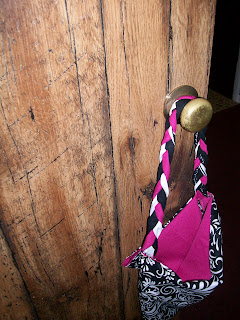Here are the supplies:
1 old tank top
elastic
fabric
coordinating thread
that's all!!!
I apologize that there aren't pictures for every step of the process (really for any of the steps), but I wasn't sure how this was going to work out and figured I'd take pictures of the next one. If I do another, which I'm sure I will, I'll add those pictures to this entry so you can see the process start-to-finish.
Step 2: Cut your tank top where you made the mark, the whole way across. I used a cutting mat, ruler, and rotary cutter, but you can use scissors if you're confident in your ability to go straight!
Step 4: Fold the bottom over one more time, then pin the right sides of your tank and elastic together. These tanks should be stretchy by nature, but you'll obviously need to stretch the tank to get the whole way around the elastic.
TIP FOR MEASURING ELASTIC:
I did this 2 ways and found the elastic worked better and made for a more flattering dress when I cut it to a length that fit snugly around my waist when I gave it just a little stretch! If you don't stretch it at all when you measure, it will just kind of hang there. But you also don't want to stretch it the whole way, or it won't have enough extra stretch for you to get your dress on and off.
Step 5: Once your elastic and tank are pinned, sew them together. I used a zig-zag stitch and went right on the edge of the fabric and elastic. I feel like the zig-zag was more secure than just sewing a straight line... but do it however you want. I also stretched the elastic and fabric while I sewed so that the thread didn't get sewn in UNstretched, because then you'd never have any stretch to your actual dress.
***Don't forget to leave a little extra elastic at the ends, lined up with a seam in your dress when you start step 5. After you sew the whole way around, you'll want to pull the raw edges of the elastic together and sew it shut. Obviously, you'll want the seam on the inside. I did a zig-zag stitch down the elastic TWICE for added security.
Step 6: Time for the skirt! I cheated a little bit because of my big butt. The first time around, I just used a tube for the skirt, but it definitely bubbled and made me look like a Cinderellian stepsister. You don't need a pattern to do this... you just need to cut the skirt in a slightly trapezoidal shape. (Fabric matters, here. I used a quilting fabric, but a jersey knit might have been much easier!)
Step 7: With the right sides of your skirt together, sew each side seam. Again, I did a zig-zag stitch and then an extra straight stitch for security... I plan on wearing this to work and don't want a wardrobe malfunction!
Step 8: With your skirt inside out, fold the top over once and sew around the top. This will help prevent fraying fabric.
Step 9: Take the top half of your dress and put the right side together with the right side of your skirt fabric. align the side seams of the tank top and skirt (your elastic should only have one seam). Fold down your skirt fabric again to hide your raw edge. Pin the right sides of your top and skirt together. Don't forget that you'll need to stretch the elastic to get the whole way around the skirt. When you're done, your fabric will fold and wrinkle along the elastic, and that is what you want!
Tip: Pin the sides at the seams first. This way you don't over- or under-stretch your elastic when you pin the rest of it together.
Step 10: Sew around the waistband, being sure to stretch the elastic until your fabric is flat. This will give your thread that "stretch" that it needs to allow you to get the dress on and off. Again, I used the zig-zag stitch.
Step 11: With your dress inside out, sew a hem along the bottom of the skirt. I folded mine twice and sewed once. My fabric was prone to fraying and doing the double hem will ensure that I don't have strings hanging out at the bottom of my dress.
PHEW! That was a lot of work! It was pretty quick and easy though... it took about the same amount of time as going to the store, trying on a few dresses, and coming home empty handed because you couldn't find the right color, size, pricepoint, etc.
Ready to see what you've accomplished?
I hope you enjoyed this tutorial. As I said, once I do another one of these I'll add more pictures so you can see the steps!
Inspired by Pinterest: Inspiration I and Inspiration II



























